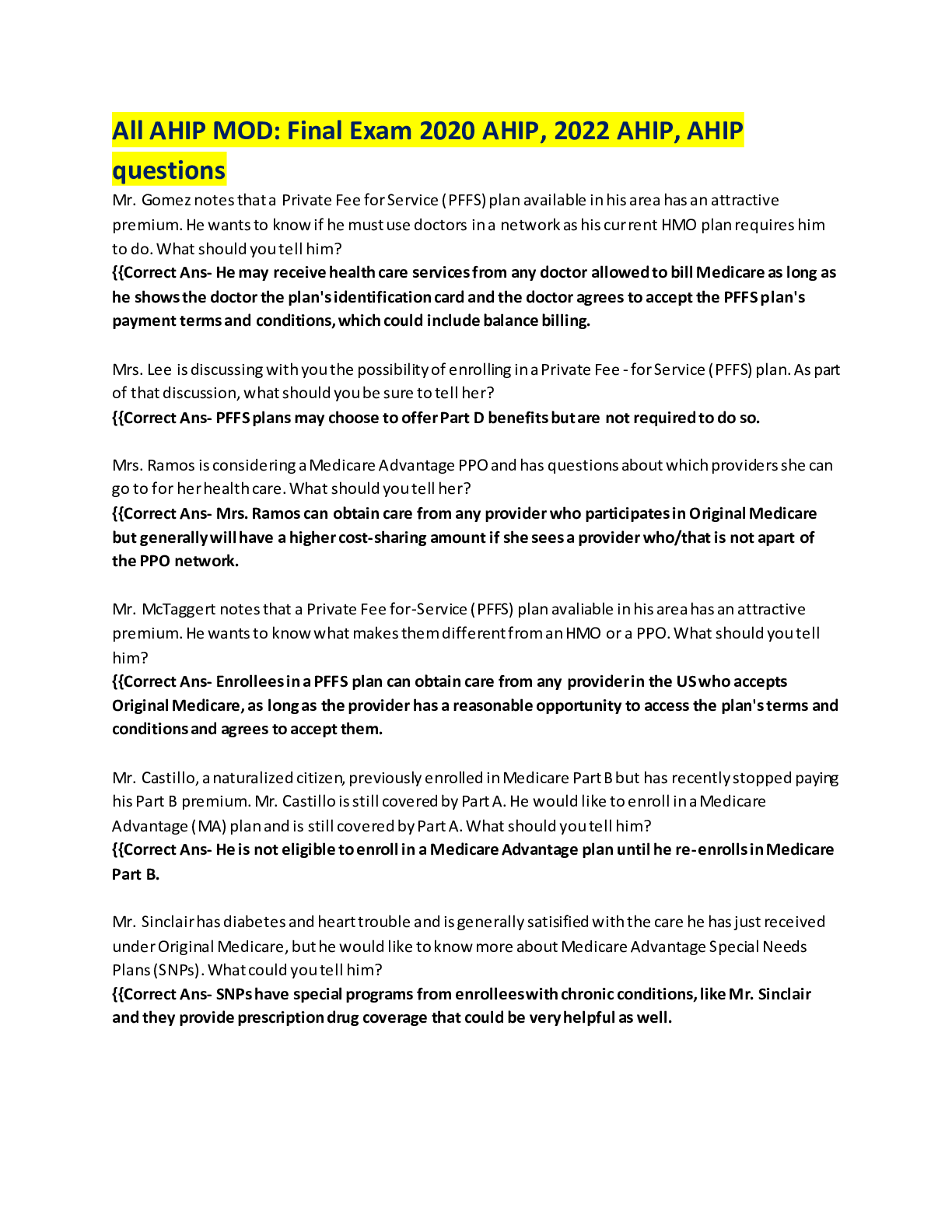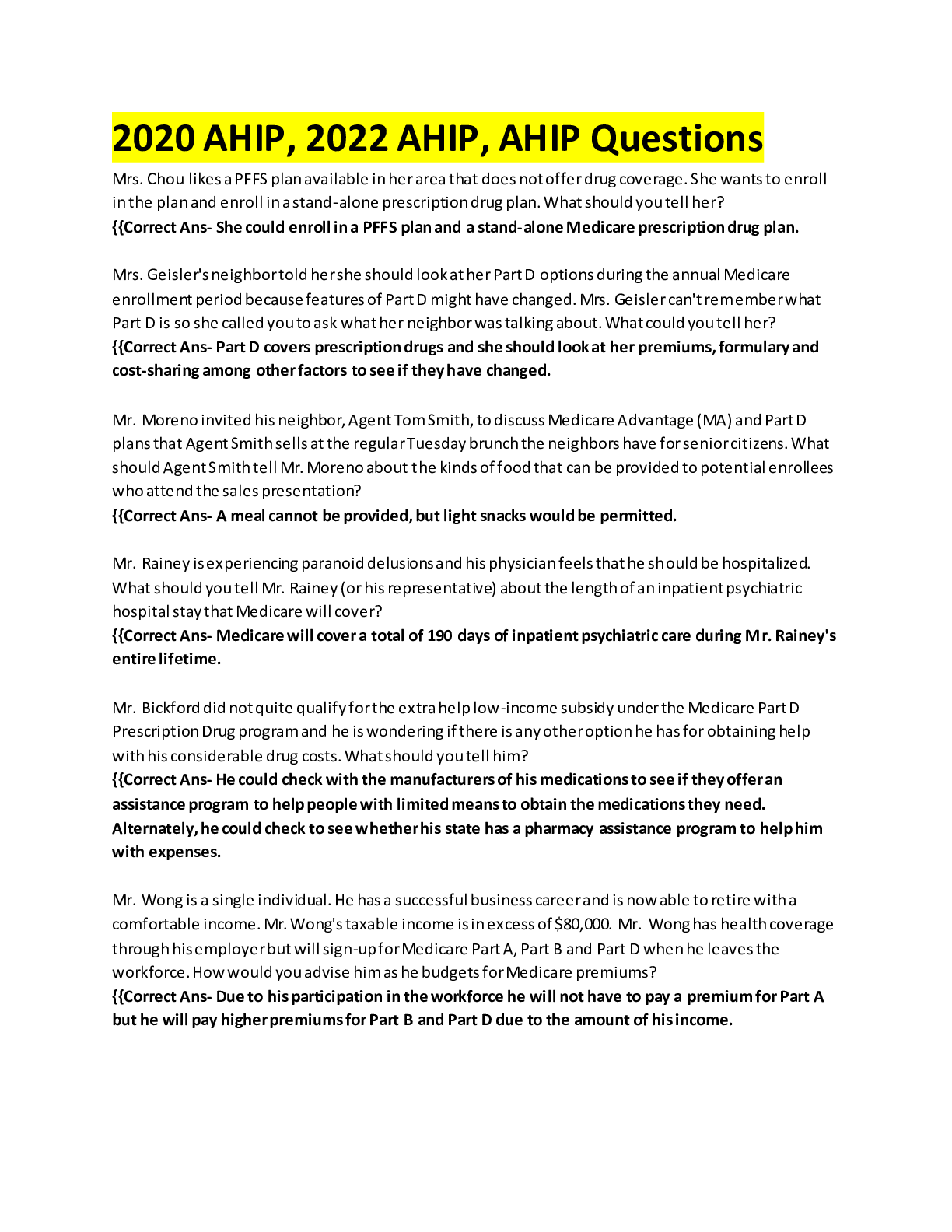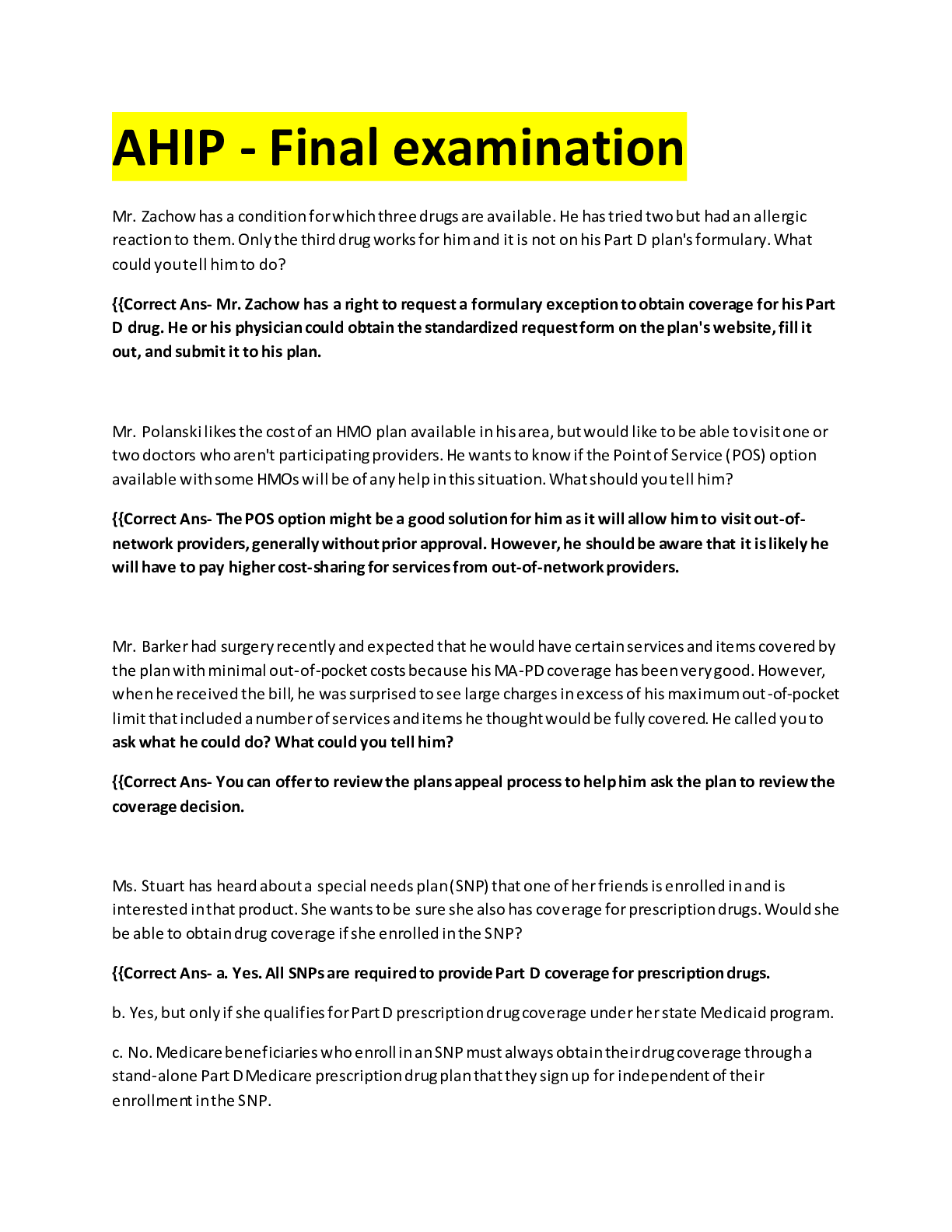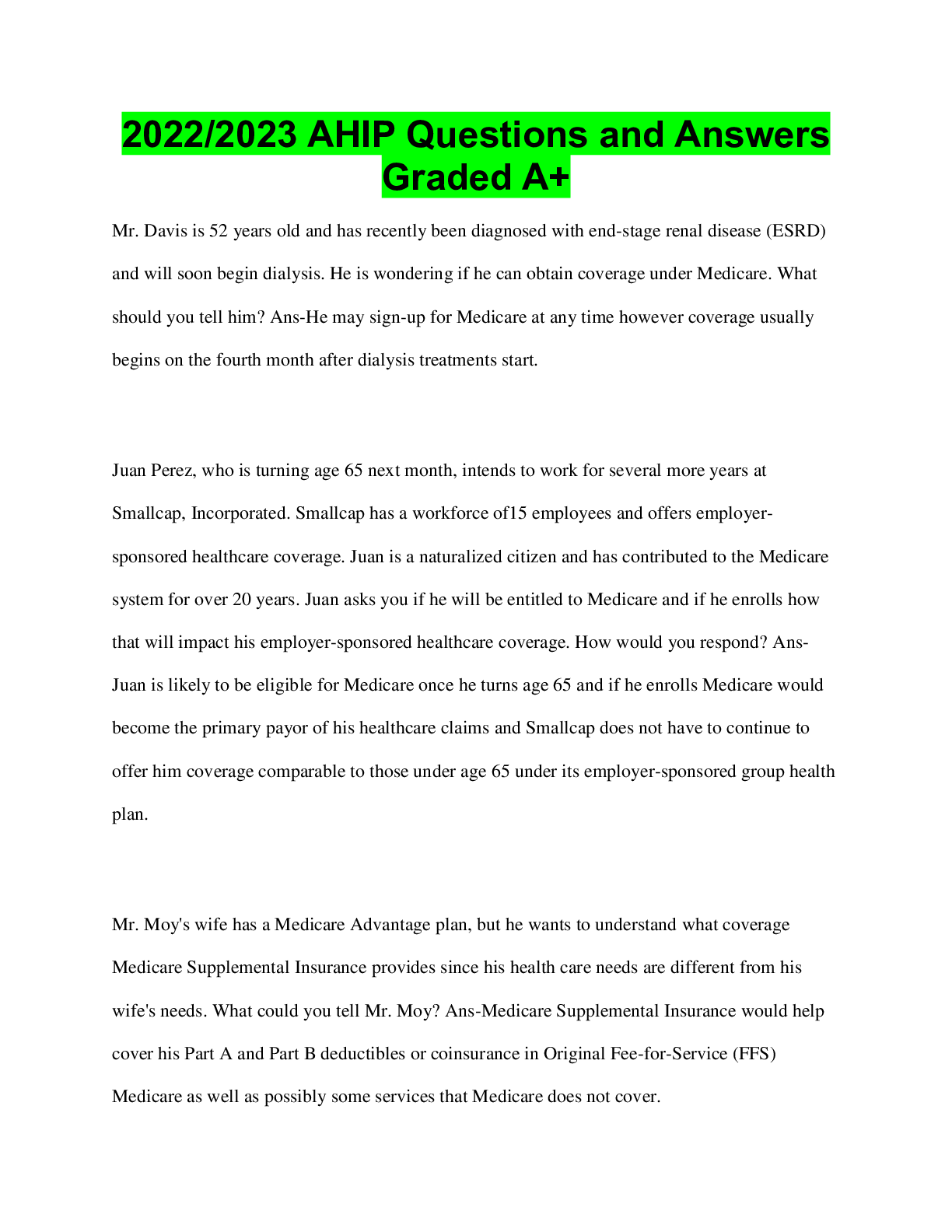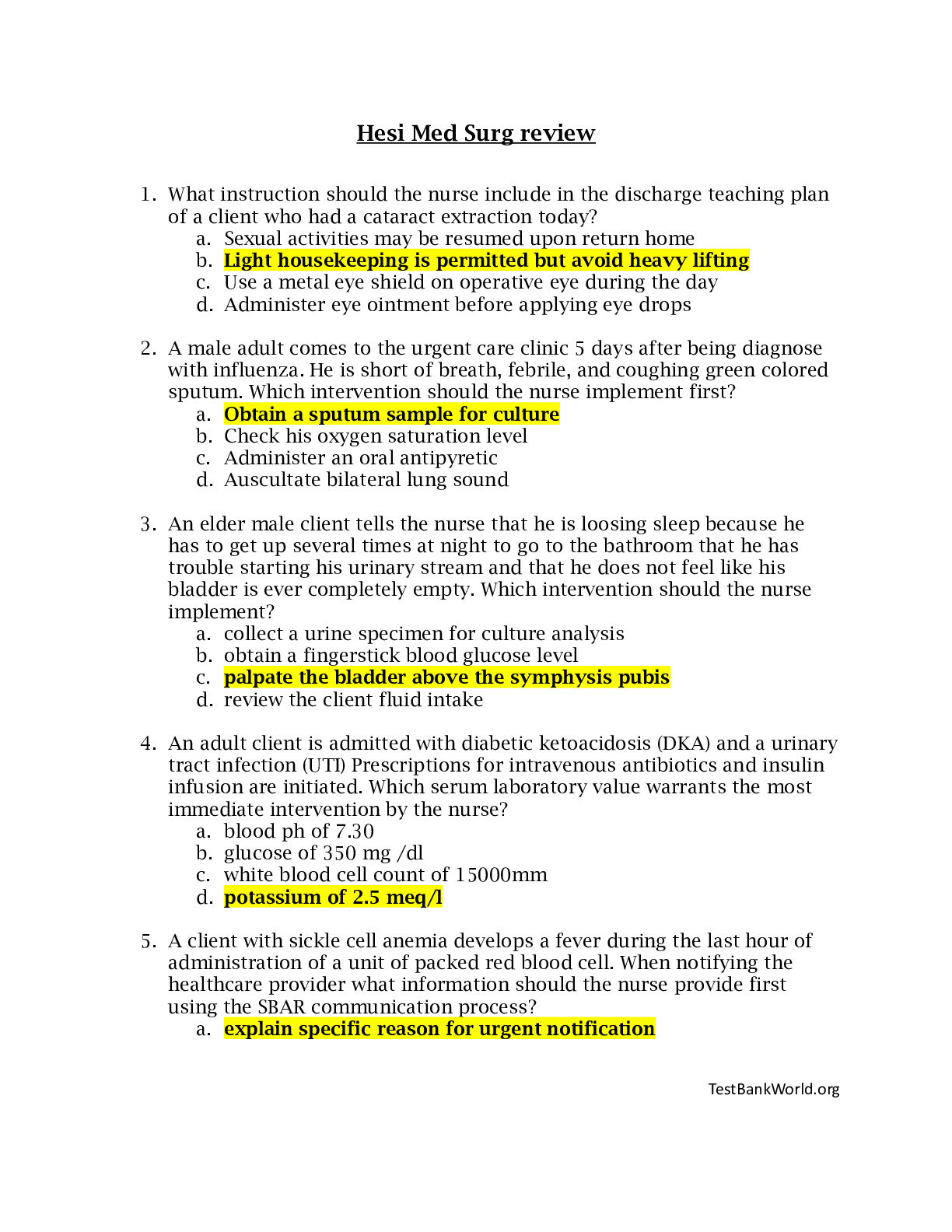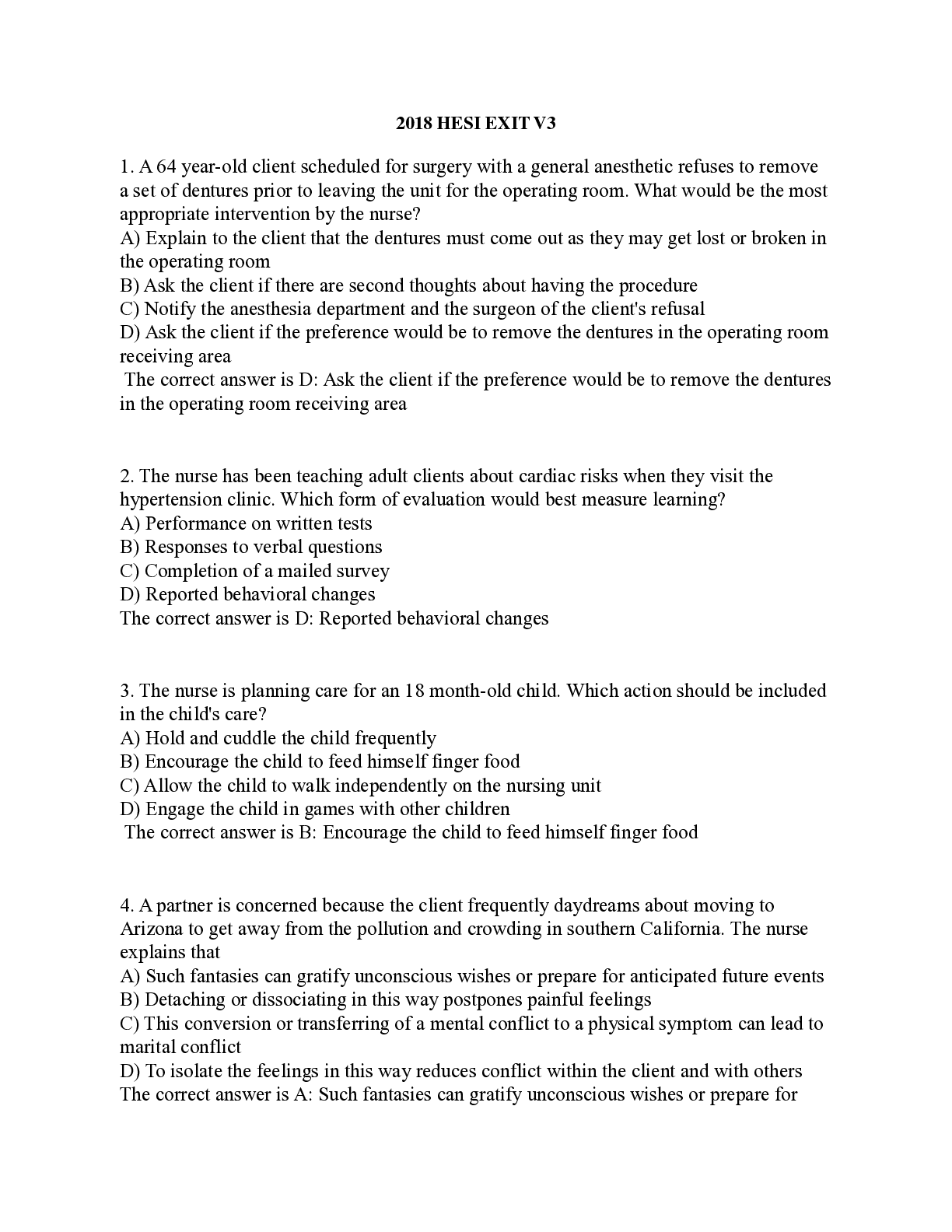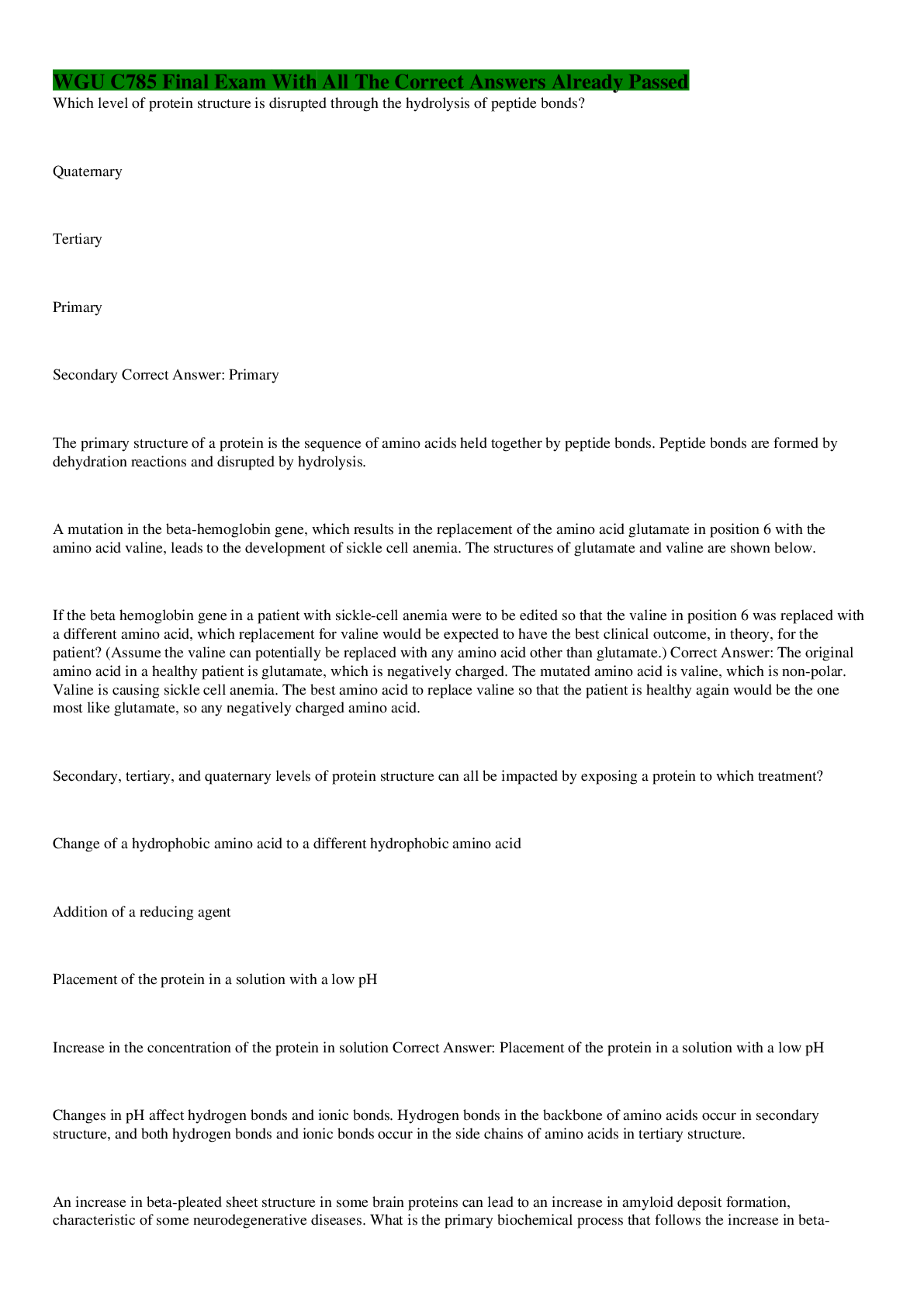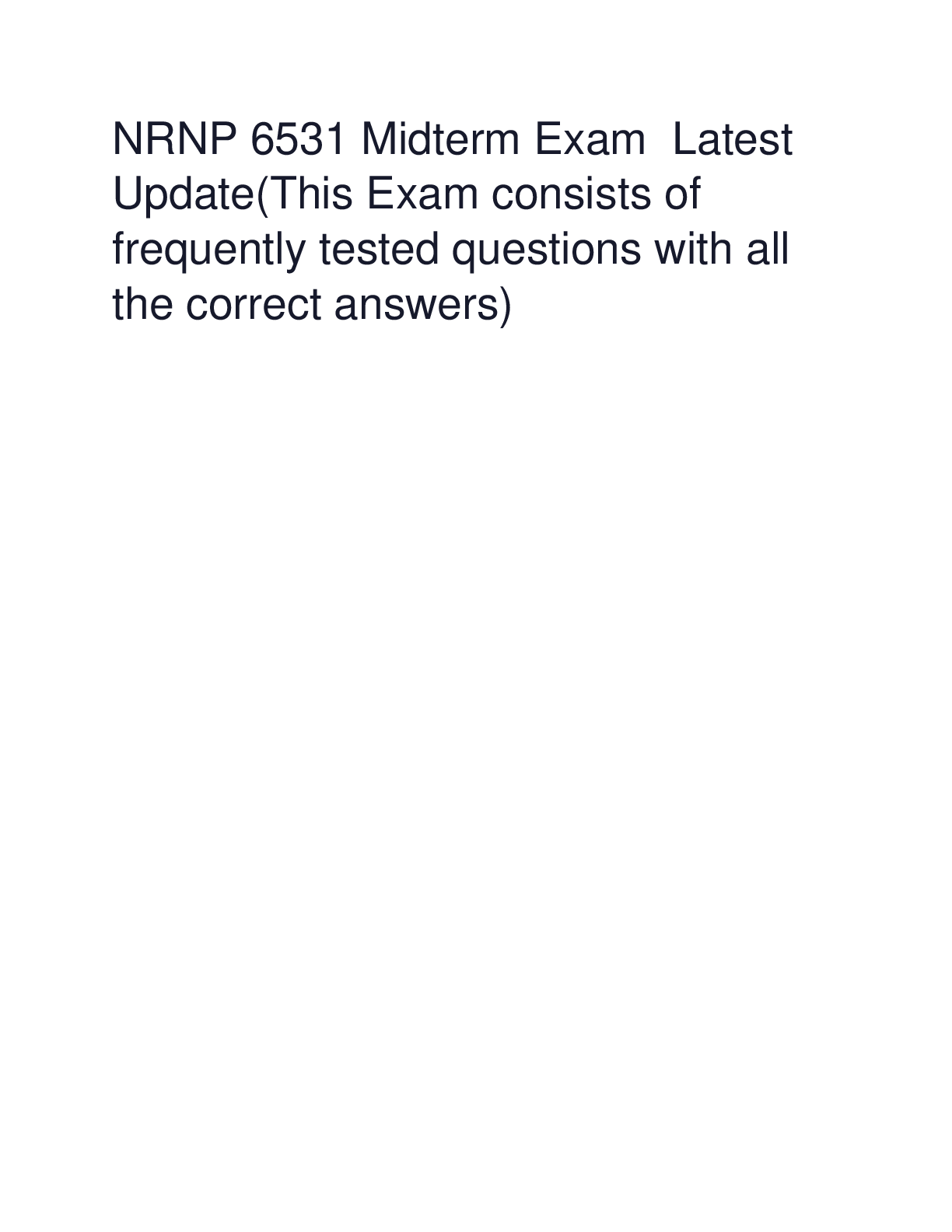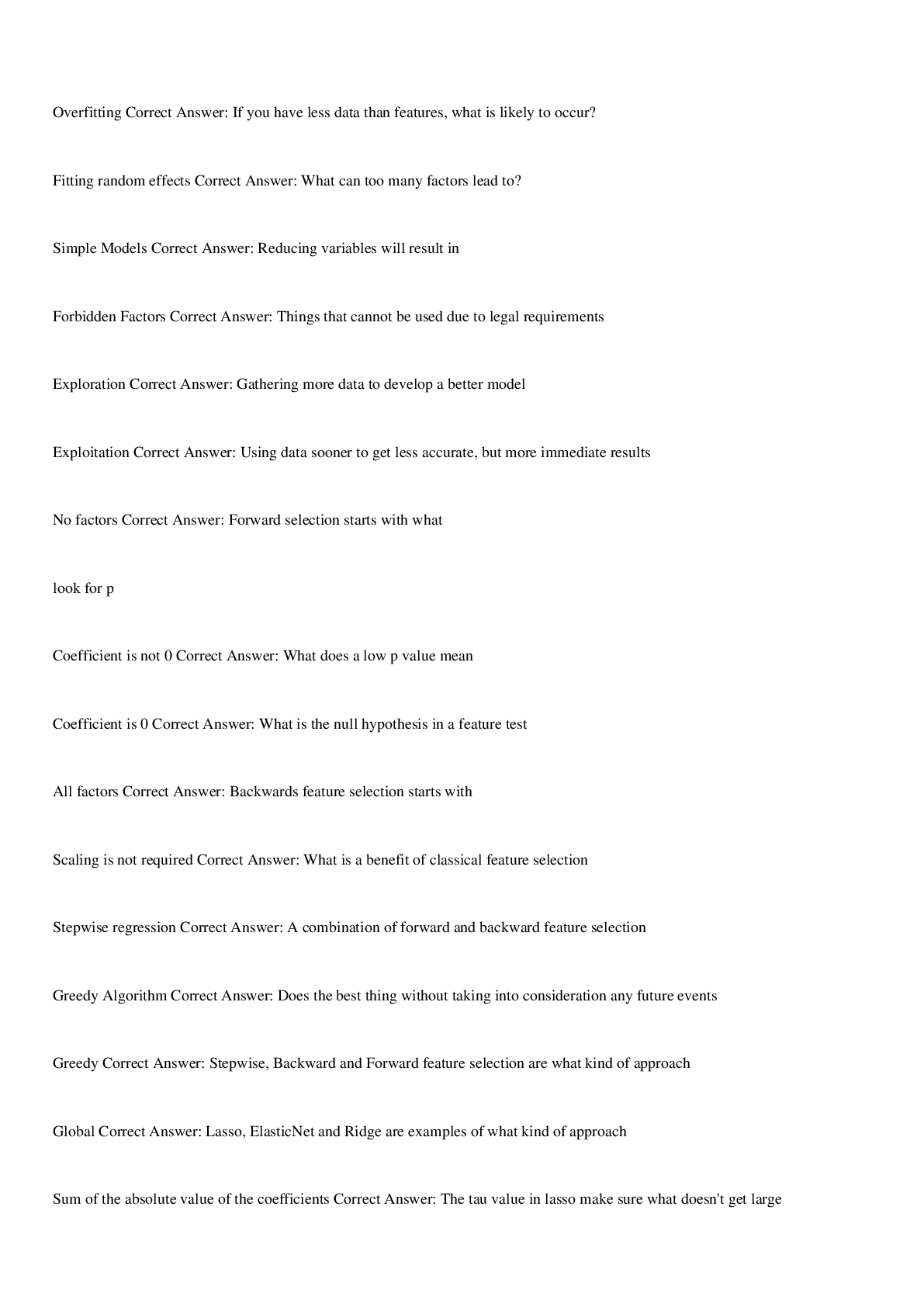Health Care > EXAM > Nursing_knowledge_Assessment_Practice_Exam PN EXIT EXAM V3 110 QUESTIONS AND ANSWER(S) UPDATED WITH (All)
Nursing_knowledge_Assessment_Practice_Exam PN EXIT EXAM V3 110 QUESTIONS AND ANSWER(S) UPDATED WITH THE CORRECT ANSWERS HIGHLIGHTED
Document Content and Description Below
HESI PN EXIT EXAM V3 110 QUESTIONS AND ANSWER(S) UPDATED WITH THE CORRECT ANSWERS HIGHLIGHTED. • • HESI PN EXIT EXAM V3 110 QUESTIONS • AND ANSWER(S) 301. If the nurse is initiating IV ... fluid replacement for a child who has dry, sticky mucous membranes, flushed skin, and fever of 103.6 F. Laboratory finding indicate that the child has a sodium concentration of 156 mEq/L. What physiologic mechanism contributes to this finding? Correct Answer: Insensible loss of body fluids contributes to the hemoconcentration of serum solutes. Rationale: Fever causes insensible fluid loss, which contribute to fluid volume and results in hemoconcentration of sodium (serum sodium greater than 150 mEq/L). Dehydration, which is manifested by dry, sticky mucous membranes, and flushed skin, is often managed by replacing lost fluids and electrolytes with IV fluids that contain varying concentration of sodium chloride. Although other options are consistent with fluid volume deficit, the physiologic response of hypernatremia is explained by hem concentration. 302. During a Woman's Health fair, which assignment is the best for the Practical Nurse (PN) who is working with a register nurse (RN) Correct Answer: Prepare a woman for a bone density screening. Rationale: A bone density screening is a fast, noninvasive screening test for osteoporosis that can be explained by the PN. There is no additional preparation needed (A) required a high level of communication skill to provide teaching and address the client's fear. (B) Requires a higher level of client teaching skill than responding to one client. (D) Requires higher level of knowledge and expertise to provide needed teaching regarding this complex topic. 303. An adult client present to the clinic with large draining ulcers on both lower legs that are characteristics of Kaposi's sarcoma lesions. The client is accompanied by two family member. Which action should the nurse take? Correct Answer: Send family to the waiting area while the client's history is taking. Rationale: To protect the client privacy, the family member should be asked to wait outside while the client's history is take. Gloves should be worn when touching the client's body fluids if the client is HIV positive and these lesion are actually Kaposi sarcoma lesion. HIV testing cannot legally be done without the client explicit permission. A further assessment can be implemented after the family left the room. 304. An adult client is exhibit the maniac stage of bipolar disorder is admitted to the psychiatric unit. The client has lost 10 pounds in the last two weeks and has no bathed in a week "I'm trying to start a new business and "I'm too busy to eat". The client is oriented to time, place, person but not situation. Which nursing problem has the greatest priority? Correct Answer: Imbalance nutrition. Rationale: The client's nutritional status has the highest priority at this time, and finger foods are often provided, so the client who is on the maniac phase of bipolar disease can receive adequate nutrition. Other options are nursing problems that should also be addresses with the client's plan of care, but at this stage in the client's treatment, adequate nutrition is a priority. 305. The nurse is preparing a discharge teaching plan for a client who had a liver transplant. Which instruction is most important to include in this plan? Correct Answer: Avoid crowds for first two months after surgery. Rationale: Cyclosporine immunosuppression therapy is vital in the success of liver transplantation and can increase the risk for infection, which is critical in the first two months after surgery. Fever is often. 306. The nurse is assessing a client's nailbeds. Witch appearance indicates further follow-up is needed for problems associated with chronic hypoxia? Correct Answer: 307. A client who had a percutaneous transluminal coronary angioplasty (PTCA) two weeks ago returns to the clinic for a follow up visit. The client has a postoperative ejection fraction ejection fraction of 30%. Today the client has lungs which are clear, +1 pedal edema, and a 5pound weight gain. Which intervention the nurse implement? Correct Answer: Assess compliance with routine prescriptions. Rationale: Fluid retention may be a sign that the client is not taking the medication as prescribed or that the prescriptions may need adjustment to manage cardiac function post-PTCA (normal ejection fraction range is 50 to 75%). 308. The RN is assigned to care for four surgical clients. After receiving report, which client should the nurse see first? The client who is Correct Answer: Three days postoperative colon resection receiving transfusion of packed RBCs. 309. The nurse is preparing an older client for discharge following cataract extraction. Which instruction should be include in the discharge teaching? Correct Answer: Avoid straining at stool, bending, or lifting heavy objects. Rationale: after cataract surgery, the client should avoid activities which increase pressure and place strain on the suture line. 310. The healthcare provider prescribes potassium chloride 25 mEq in 500 ml D_5W to infuse over 6 hours. The available 20 ml vial of potassium chloride is labeled, "10 mEq/5ml." how many ml of potassium chloride should the nurse add the IV fluid? (Enter numeric value only. If is rounding is required, round to the nearest tenth.) Correct Answer: 12.5. Rationale: Using the formula D / H X Q: 25 mEq / 10 mEq x 5ml ꞊12.5ml 311. At 40 week gestation, a laboring client who is lying is a supine position tells the nurse that she has finally found a comfortable position. What action should the nurse take? Correct Answer: Place a wedge under the client's right hip. Rationale: Hypotension from pressure on the vena cava is a risk for the full-term client. Placing a wedge under the right hip will relieve pressure on the vena cava. Other options will either not relieve pressure on the vena cava or would not allow the client the remaining her position of choice. 312. A client with a history of diabetes and coronary artery disease is admitted with shortness of breath, anxiety, and confusion. The client's blood pressure is 80/60 mmHg, heart rate 120 beats/minute with audible third and fourth heart sounds, and bibasilar crackles. The client's average urinary output is 5 ml/hour. Normal saline is infusing at 124 ml/hour with a secondary infusion of dopamine at mcg/kg/minute per infusion pump. With intervention should the nurse implement? Correct Answer: Titrate the dopamine infusion to raise the BP. Rationale: the client is experiencing cardiogenic shock and requires titration per protocol of the vasoactive secondary infusion, dopamine, to increase the blood pressure. Low hourly urine output is due to shock and does not indicate a need for catheter irrigation. Pacing is not indicated based on the client's capillary blood glucose should be monitored, but is not directly indicated at this time. 313. The nurse ends the assessment of a client by performing a mental status exam. Which statement correctly describes the purpose of the mental status exam? Correct Answer: Evaluate the client's mood, cognition and orientation. Rational: the mental status exam assesses the client for abnormalities in cognitive functioning; potential thought processes, mood and reasoning, the other options listed are all components of the client's psychosocial assessment. 314. An older adult resident of a long-term care facility has a 5-year history of hypertension. The client has a headache and rate the pain 5 on a pain scale 0 to 10. The client's blood pressure is currently 142/89. Which interventions should the nurse implement? (Select all that apply) Correct Answer: Administer a daily dose of lisinopril as scheduled. Provide a PRN dose of acetaminophen for headache. Rational: the client' routinely scheduled medication, lisinopril, is an antihypertensive medication and should be administered as scheduled to maintain the client's blood pressure. A PRN dose of acetaminophen should be given for the client's headache. The other options are not indicated for this situation. 315. When conducting diet teaching for a client who is on a postoperative soft diet, which foods should eat? (Select all that apply) Correct Answer: Pasta, noodles, rice. Egg, tofu, ground meat. Mashed, potatoes, pudding, milk. Rational: a client's postoperative diet is commonly progressed as tolerated. A soft diet includes foods that are mechanically soft in texture (pasta, egg, ground meat, potatoes, and pudding. High fiber foods that require thorough chewing and gas forming foods, such as cruciferous vegetables and fresh fruits with skin, grains and seeds are omitted. 316. The nurse is preparing a 4-day-old I infant with a serum bilirubin level of 19 mg/dl (325 micromol/L) for discharge from the hospital. When teaching the parents about home phototherapy, which instruction should the nurse include in the discharge teaching plan? Correct Answer: Reposition the infant every 2 hours. Rational: An infant, who is receiving phototherapy for hyperbilirubinemia, should be repositioned every two hours. The position changes ensure that the phototherapy lights reach all of the body surface areas. Bathing, feedings, and diaper changes are ways for the parents to bond with the infant, and can occur away from the treatment. Feedings need to occur more frequently than every 4 hours to prevent dehydration. The infant should wear only a diaper so that the skin is exposed to the phototherapy. 317. When planning care for a client with acute pancreatitis, which nursing intervention has the highest priority? Correct Answer: Withhold food and fluid intake. Rational: The pathophysiologic processes in acute pancreatitis result from oral fluid and ingestion that causes secretion of pancreatic enzymes, which destroy ductal tissue and pancreatic cells, resulting in auto digestion and fibrosis of the pancreas. The main focus of the nursing care is reducing pain caused by pancreatic destruction through interventions that decrease GI activity, such as keeping the client NPO. Other choices are also important intervention but are secondary to pain management. 318. Assessment by the home health nurse of an older client who lives alone indicates that client has chronic constipations. Daily medications include furosemide for hypertension and heart failure and laxatives. To manage the client's constipation, which suggestions should the nurse provide? (Select all that apply) Correct Answer: Include oatmeal with stewed pruned for breakfast as often as possible. Increase fluid intake by keeping water glass next to recliner. Recommend seeking help with regular shopping and meal preparation. Rational: older adult are at higher risk for chronic constipation due to decreased gastrointestinal muscle tone leading to reduce motility. Oatmeal with prunes increases dietary fiber and bowel stimulation, thereby decreasing need for laxatives. Increased fluid intake also decreases constipations. Assistance with food preparation might help the client eat more fresh fruits and vegetables and result on less reliance on microwaved and fast foods, which are usually high in sodium and fat with little fiber. Laxatives can be reduced gradually by improving the diet, without resorting to using enemas. 319. A young boy who is in a chronic vegetative state and living at home is readmitted to the hospital with pneumonia and pressure ulcers. The mother insists that she is capable of caring for her son and which action should the nurse implement next? Correct Answer: Determine the mother's basic skill level in providing care. Rational: Although the mother states she is a capable caregiver, the client is manifesting disuse syndrome complications, and the mother's skill in providing basic care should be determined. Further assessment is needed before implementing other nursing actions. 320. After the risk and benefits of having a cardiac catheterization are reviewed by the healthcare provider, an older adult with unstable angina is scheduled for the procedure. When the nurse presents the consent form for signature, the client asks how the wires will keep a heart heating during the procedure. What action should the nurse take? Correct Answer: Notify the healthcare provider of the client's lack of understanding. Rational: the nurse is only witnessing the signature, and is not responsible for the client's understanding of the procedure. The healthcare provider needs to clarify any questions and misconceptions. Explaining the procedure again is the healthcare provider's legal responsibility. The other options are not indicated. 321. In assessing a client at 34-weeks' gestation, the nurse notes that she has a slightly elevated total T4 with a slightly enlarged thyroid, a hematocrit of 28%, a heart rate of 92 beats per minute, and a systolic murmur. Which finding requires follow-up? Correct Answer: Hematocrit of 28%. Rational: although physiologic anemia is expected in pregnancy, a hematocrit of 28% is below pregnant norms and could signify iron-deficiency anemia. Other options are normal finding pregnancy. 322. A client with osteoporosis related to long-term corticosteroid therapy receives a prescription for calcium carbonate. Which client's serum laboratory values requires intervention by the nurse? Correct Answer: Creatinine 4 mg/dl (354 micromol/L SI). 323. A clinical trial is recommended for a client with metastatic breast cancer, but she refuses to participate and tells her family that she does not wish to have further treatments. The client's son and daughter ask the nurse to try and convince their mother to reconsider this decision. How should the nurse respond? Correct Answer: Explore the client's decision to refuse treatment and offer support. Rationale: as long as the client is alert, oriented and aware of the disease prognosis, the healthcare team must abide by her decisions. Exploring the decision with the client and offering support provides a therapeutic interaction and allows the client to express her fears and concerns about her quality of life. Other options are essentially arguing with the client's decisions regarding her end of life treatment or diminish the opportunity for the client to discuss her feelings. 324. An adult client with severe depression was admitted to the psychiatric unit yesterday evening. Although the client ran one year ago, his spouse states that the client no longer runs, bur sits and watches television most of the day. Which is most important for the nurse to include in this client's plan of care for today? Correct Answer: Assist client in identifying goals for the day. Rationale: clients with severe depression have low energy and benefit from structured activities because concentration is decreased. The client participate in care by identifying goals for the day is the most important intervention for the client's first day at the unit. Other options can be implemented over time, as the depression decreases. 325. An adult who is 5 feet 5 inches (165.1 cm) tall and weighs 90 lb. (40.8 Kg) is admitted with a diagnosis of chronic anorexia. The client receives a regular diet for 2 days, and the client's medical records indicates that 100% of the diet provided has been consumed. However the client's weight on the third day morning after admission is 89 lb. (40.4 Kg). What action should the nurse implement? Correct Answer: Assign staff to monitor what the client eats. Rationale: clients with an eating disorder have an unhealthy obsession with food. The client's continued weight loss, despites indication that the client has consumed 100% of the diet, should raise questions about the client's intake of the food provided, so the client should be observed during meals to prevent hiding or throwing away food. Other options may be accurate but ineffective and unnecessary. 326. A client exposed to tuberculosis is scheduled to begin prophylactic treatment with isoniazid. Which information is most important for the nurse to note before administering the initial dose? Correct Answer: Current diagnosis of hepatitis B. Rationale: prophylactic treatment of tuberculosis with isoniazid is contraindicated for persons with liver disease because it may cause liver damage. The nurse should withhold the prescribed dose and contact the healthcare provider. Other options do not provide data indicating the need to question or withhold the prescribed treatment. 327. The nurse walks into a client's room and notices bright red blood on the sheets and on the floor by the IV pole. Which action should the nurse take first? Correct Answer: Identify the source and amount of bleeding. Rationale: the nursed should first assess the client to determine the action that should be taken. Patient safety is the priority; other options are not priority. 328. During a routine clinic visit, an older female adult tells the nurse that she is concerned that the flu season is coming soon, but is reluctant to obtain the vaccination. What action should the nurse take first? Correct Answer: Discuss the concerns expressed by the client about the vaccination. Rationale: the nurse should first address the concerns identified by th [Show More]
Last updated: 1 year ago
Preview 1 out of 14 pages
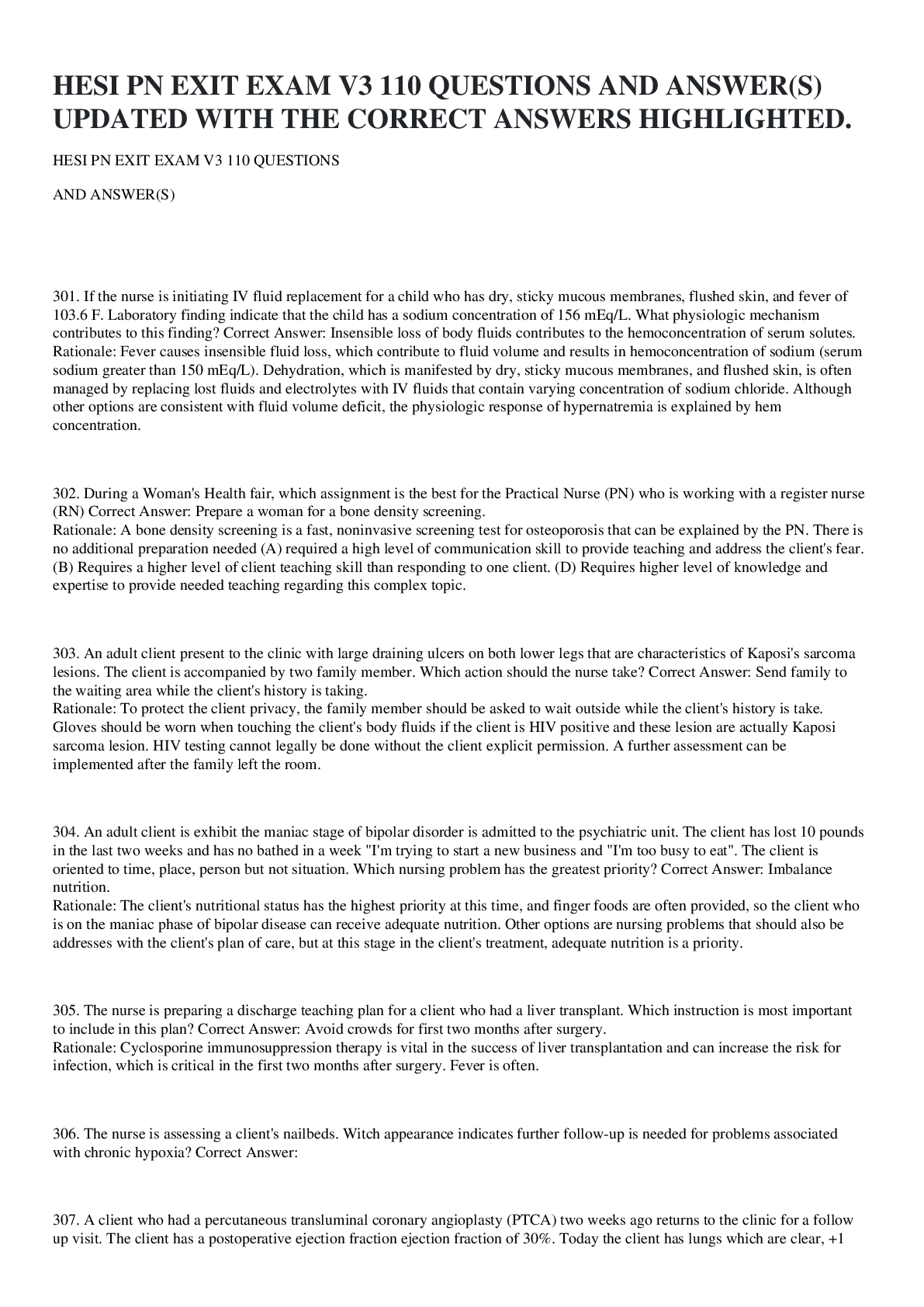
Reviews( 0 )
Document information
Connected school, study & course
About the document
Uploaded On
Jul 26, 2022
Number of pages
14
Written in
Additional information
This document has been written for:
Uploaded
Jul 26, 2022
Downloads
0
Views
48


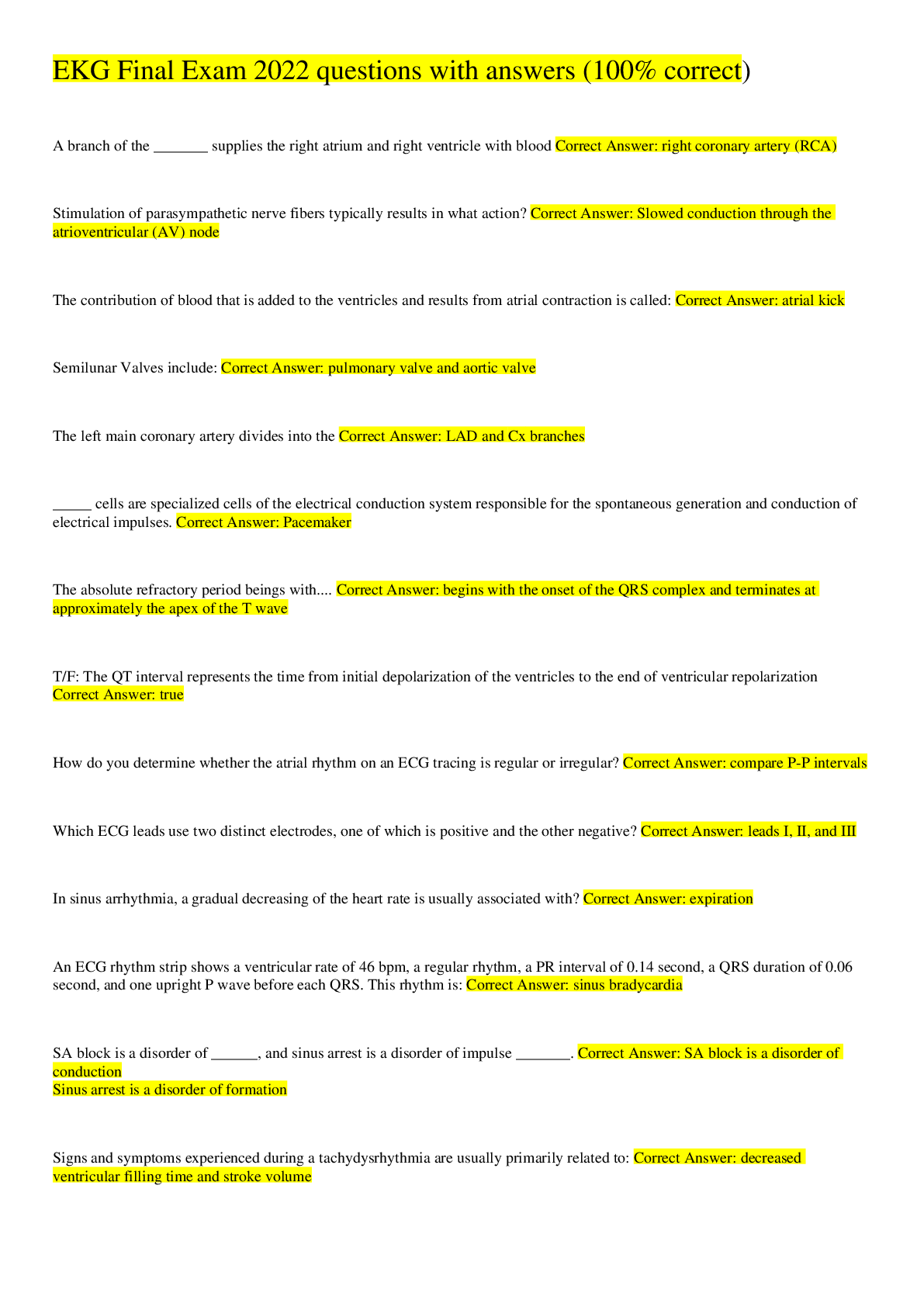
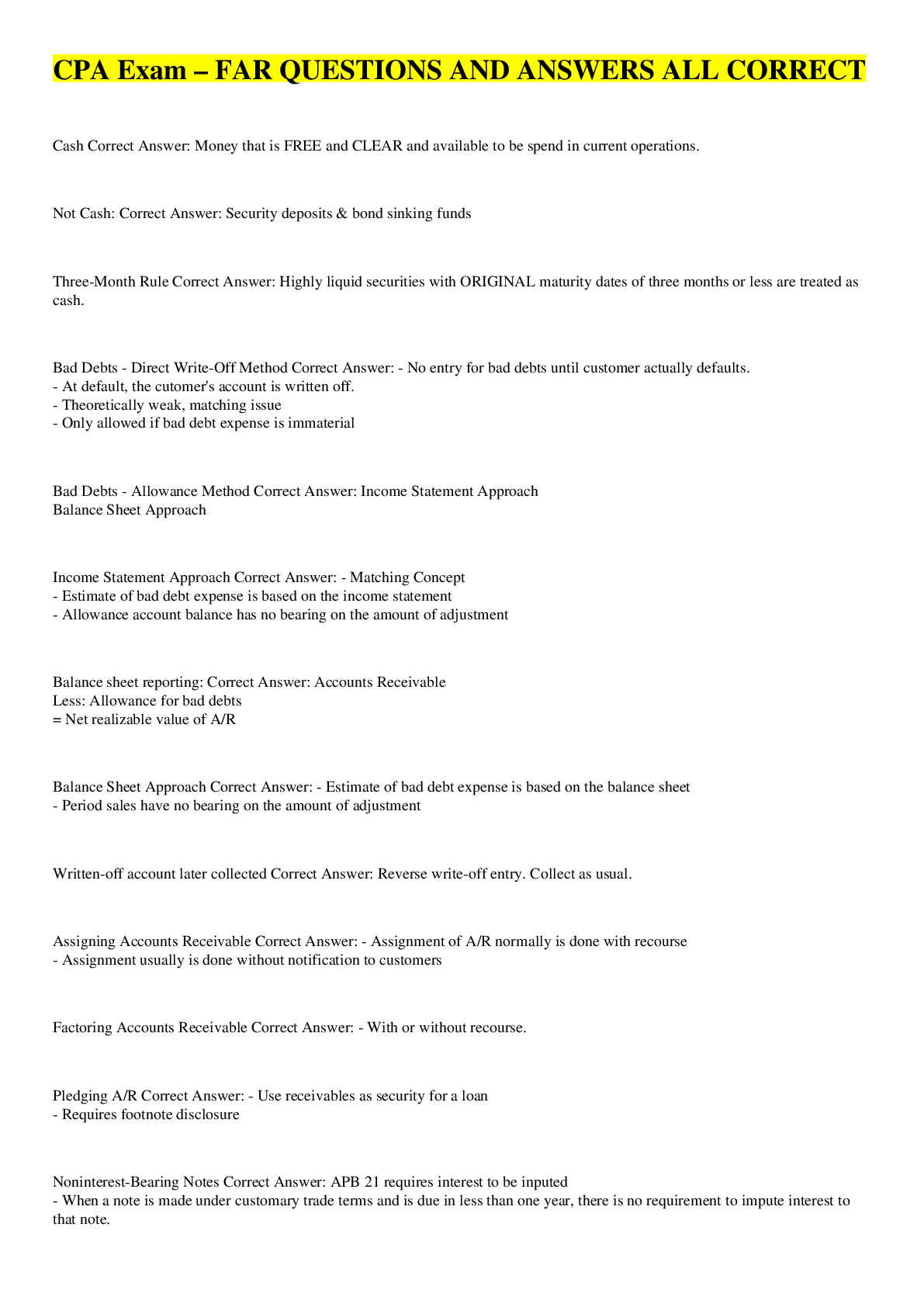
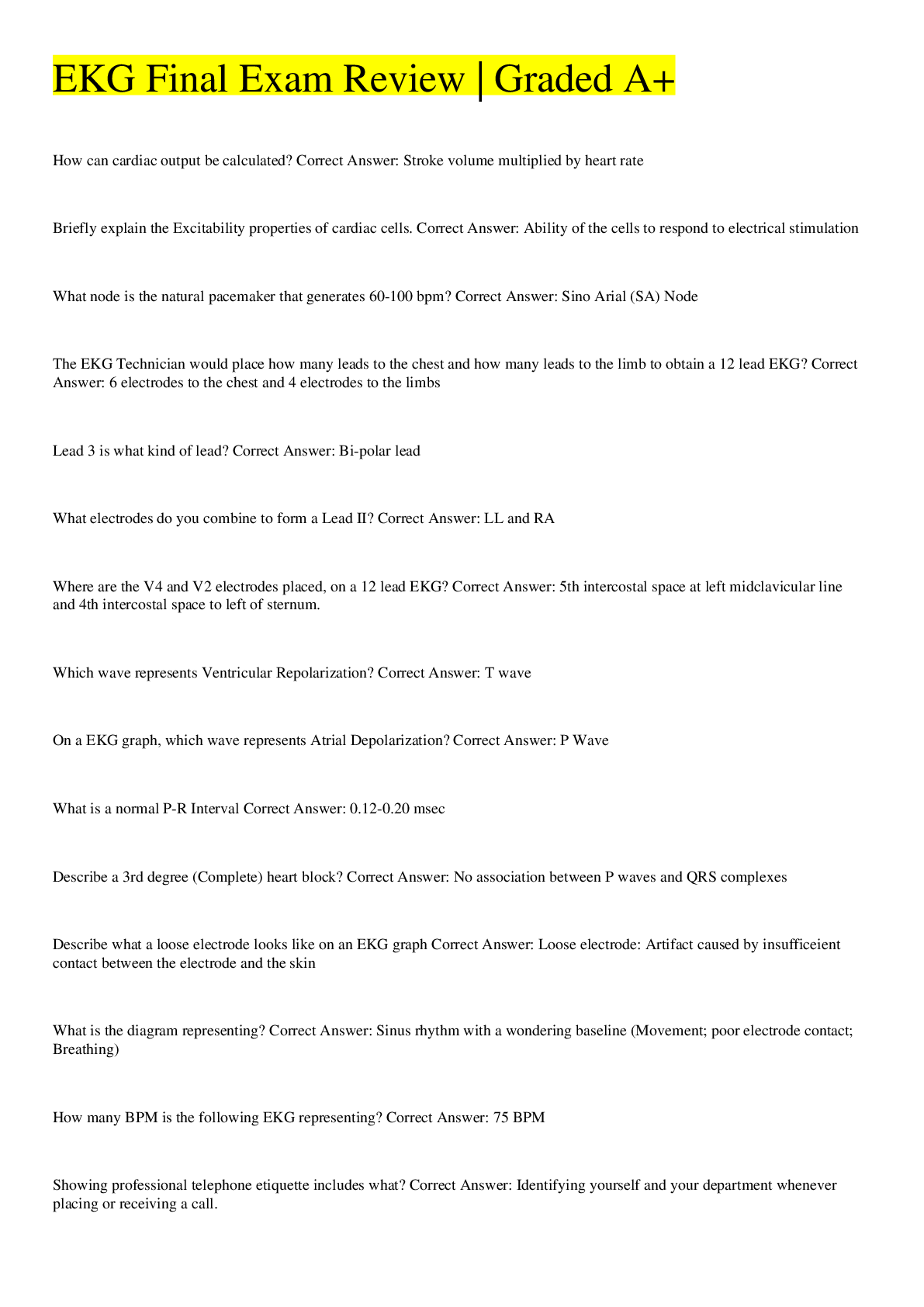
.png)

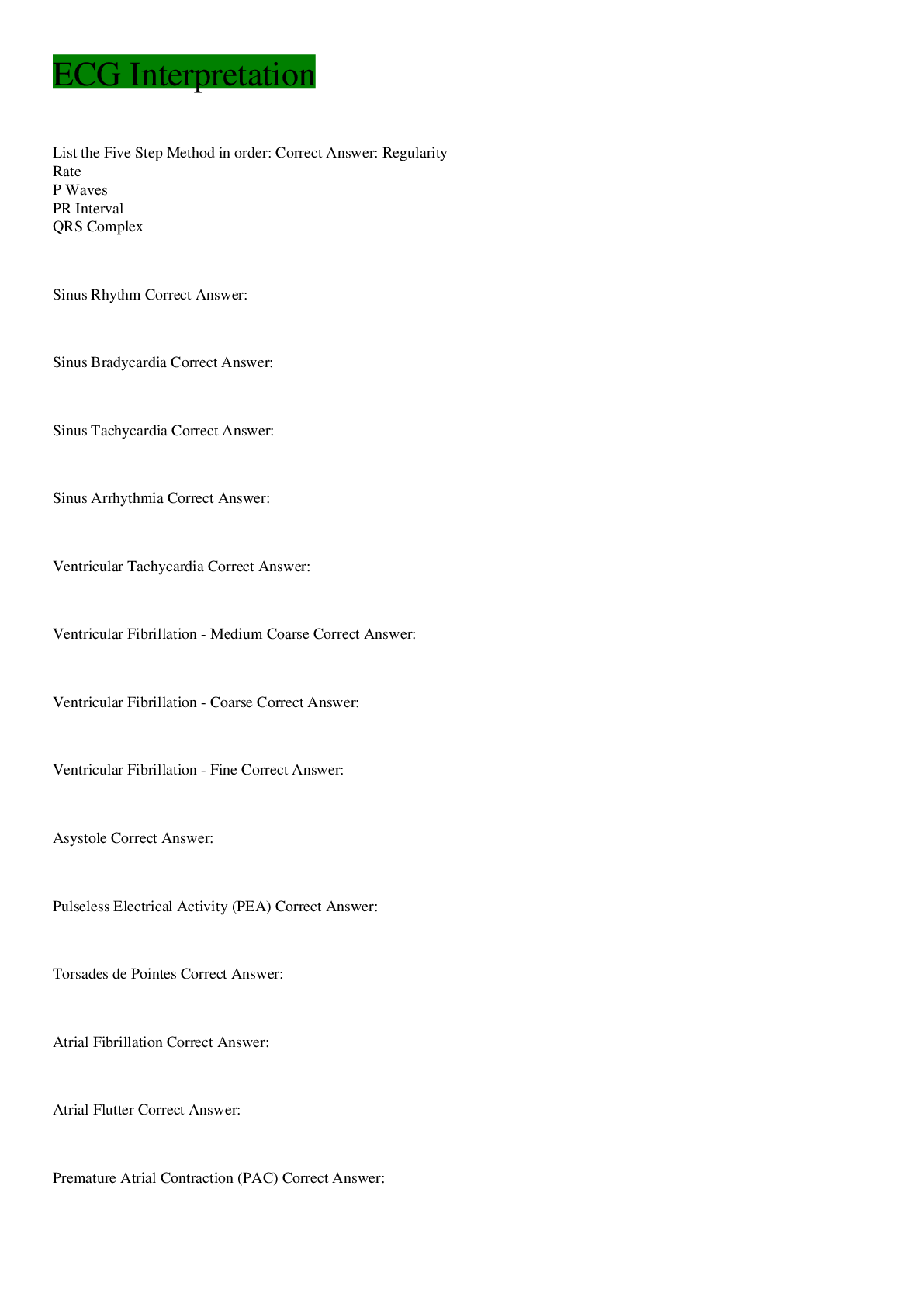


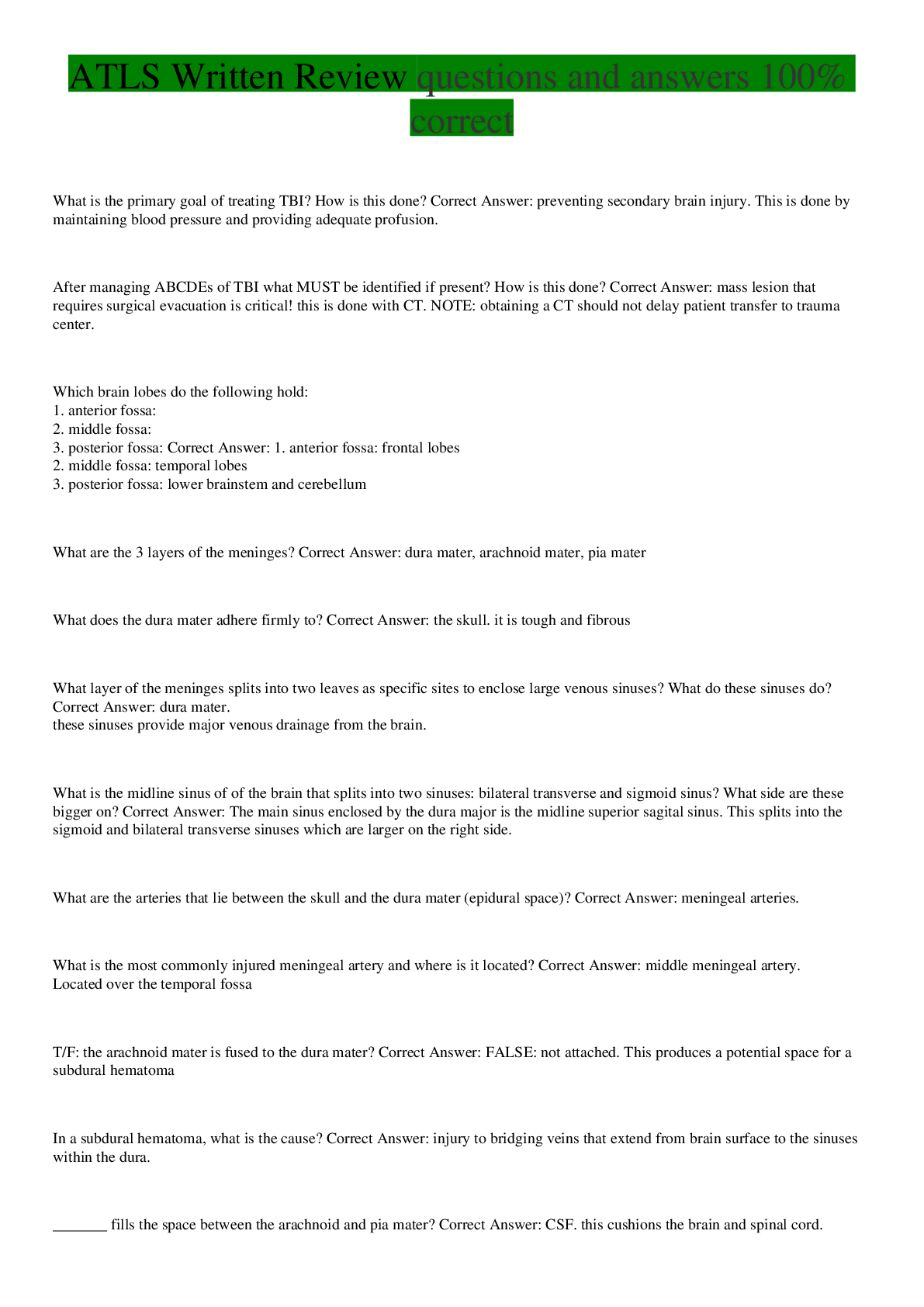
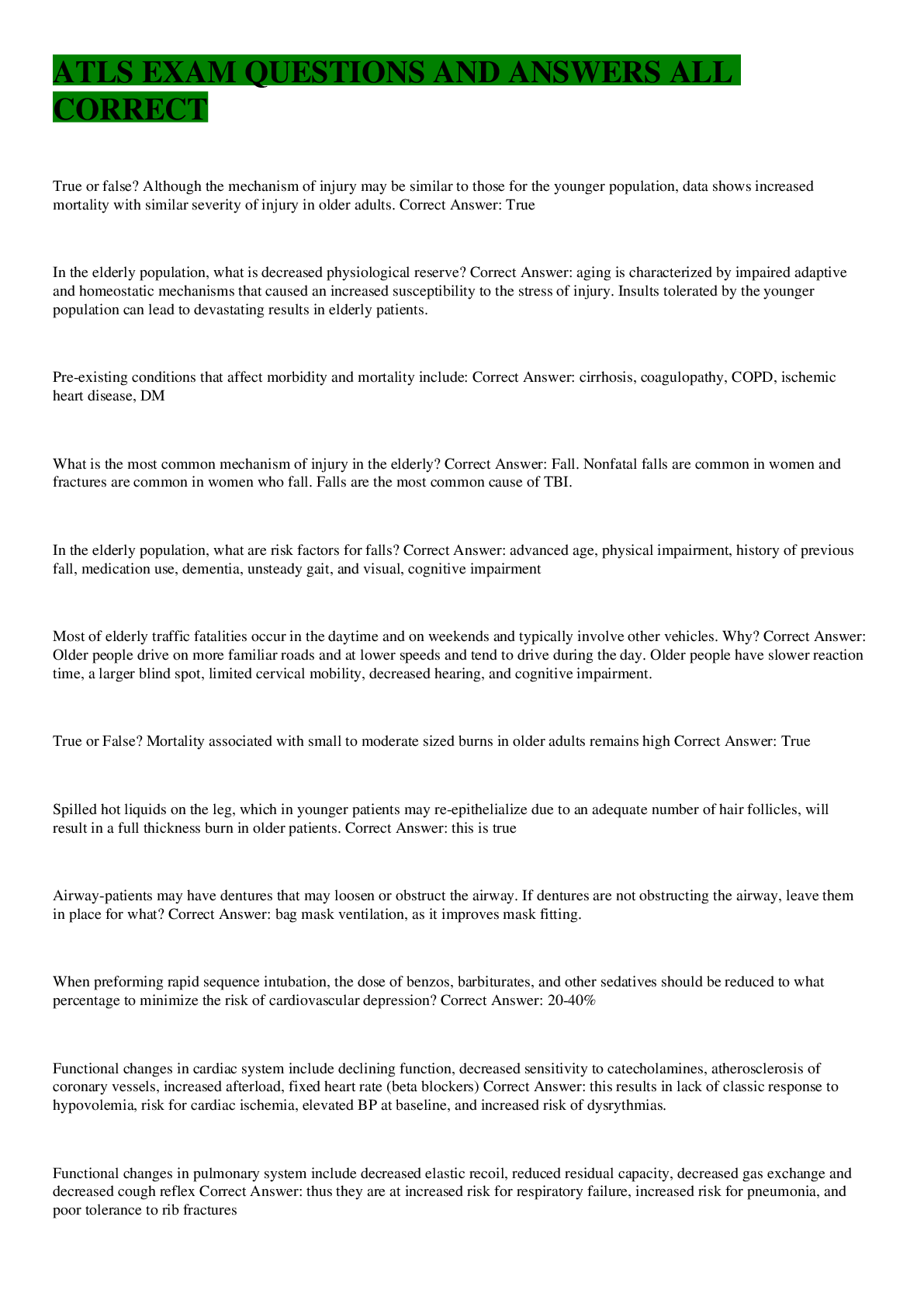


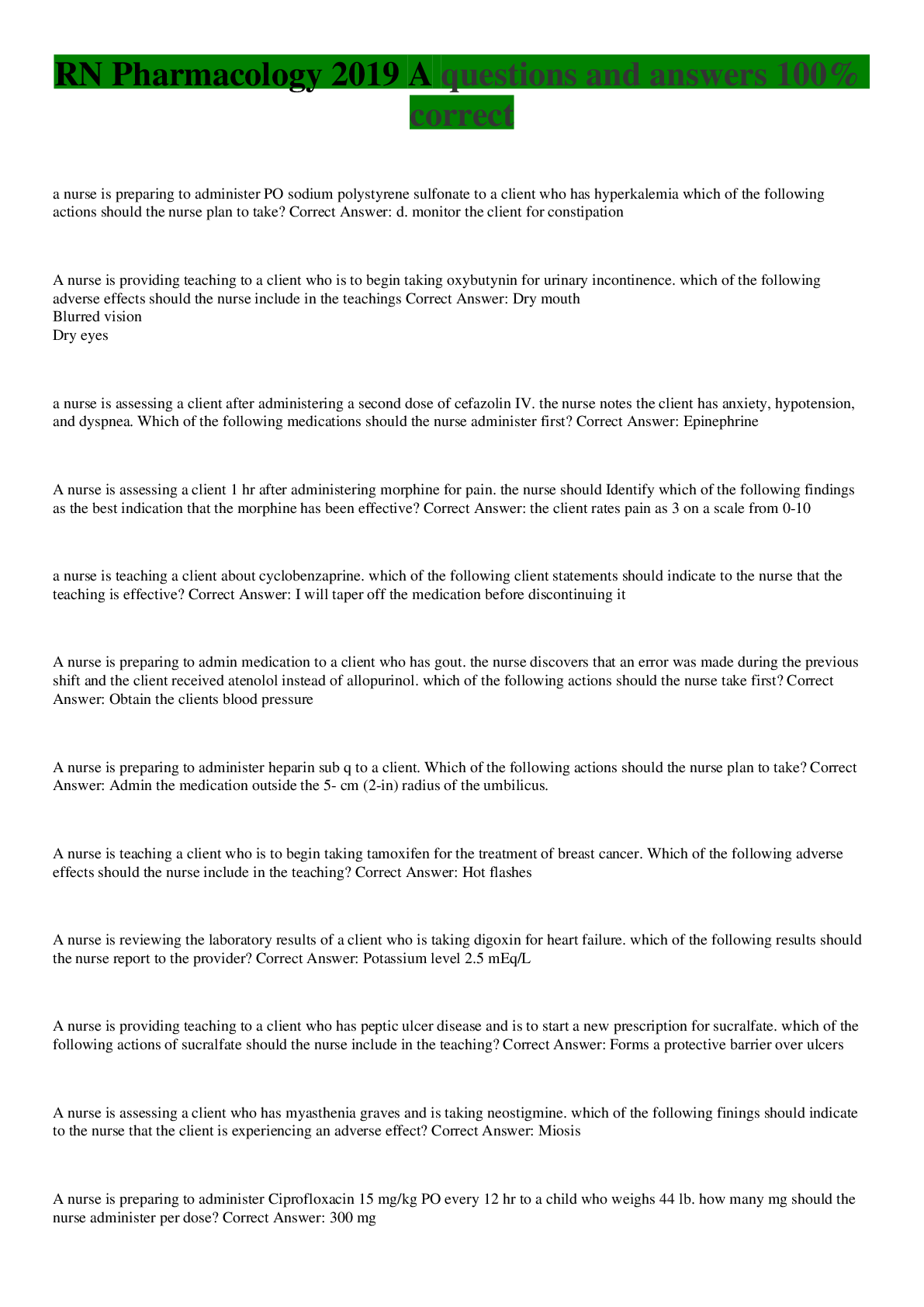
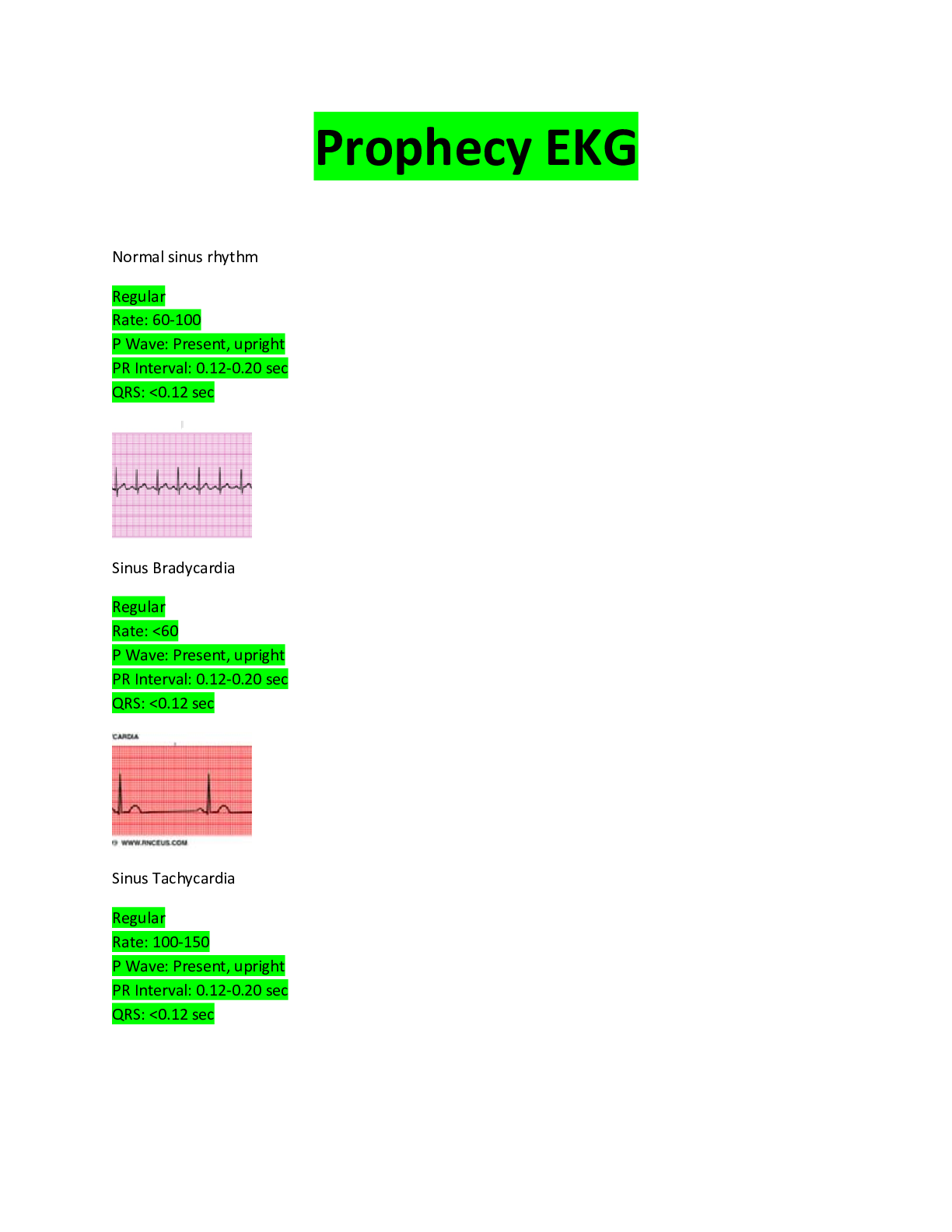
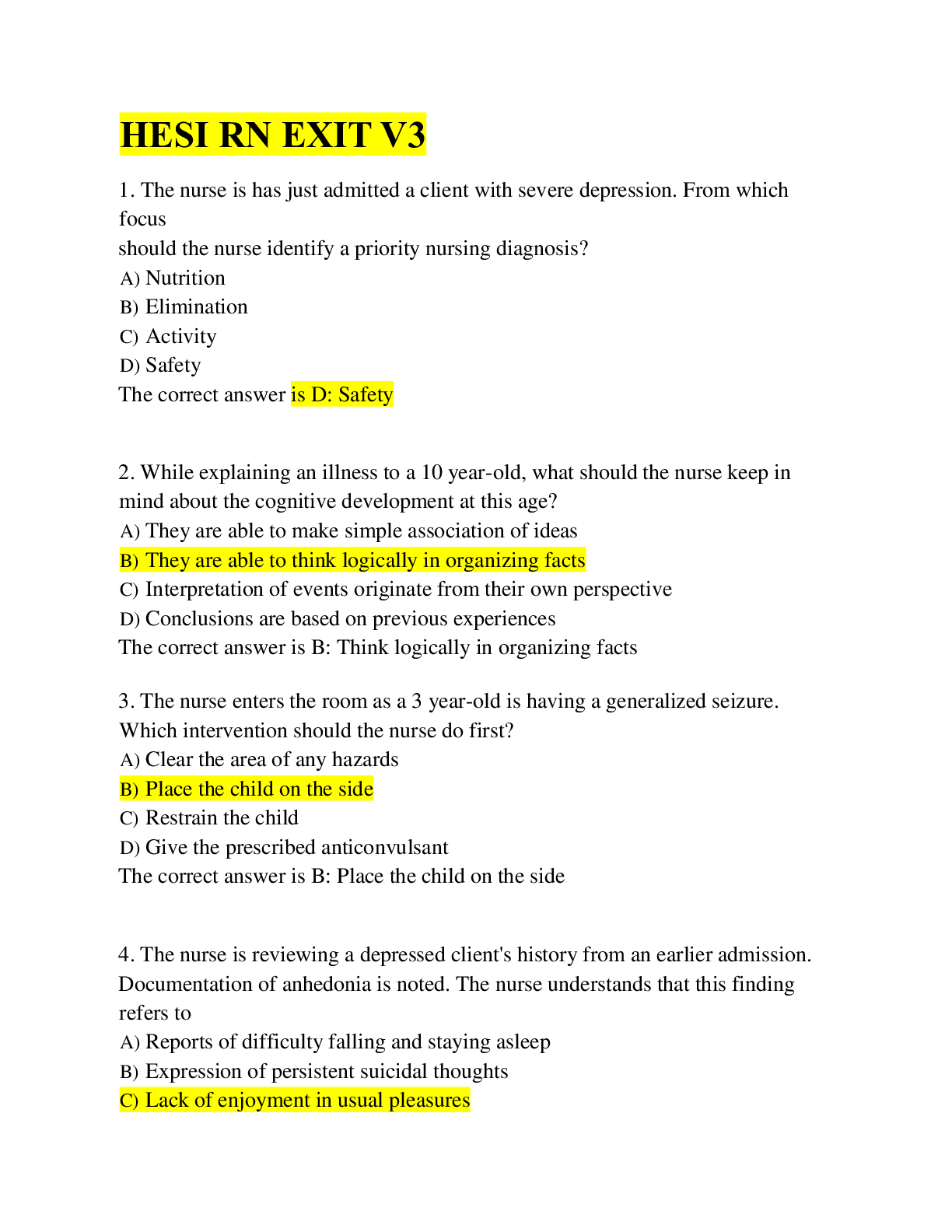

.png)


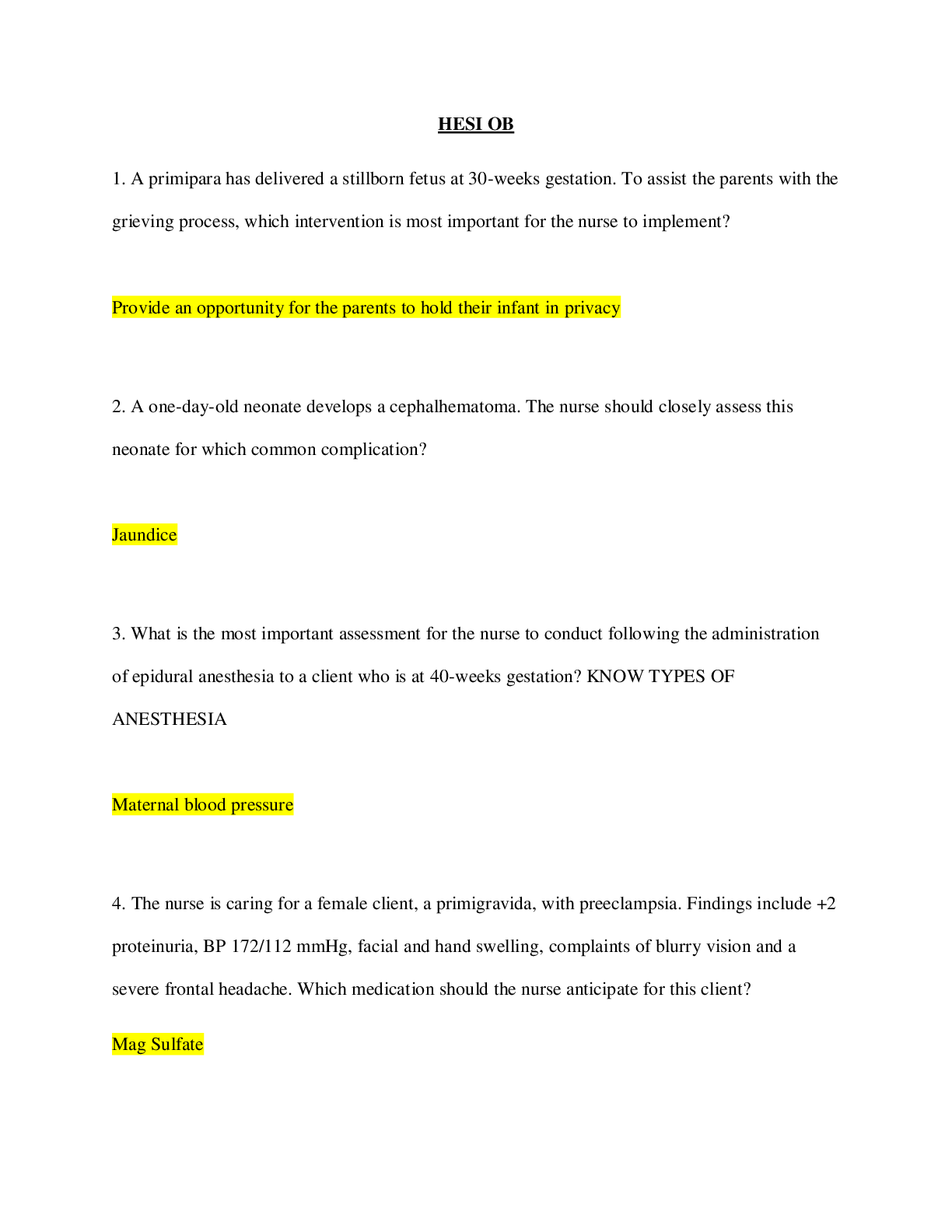
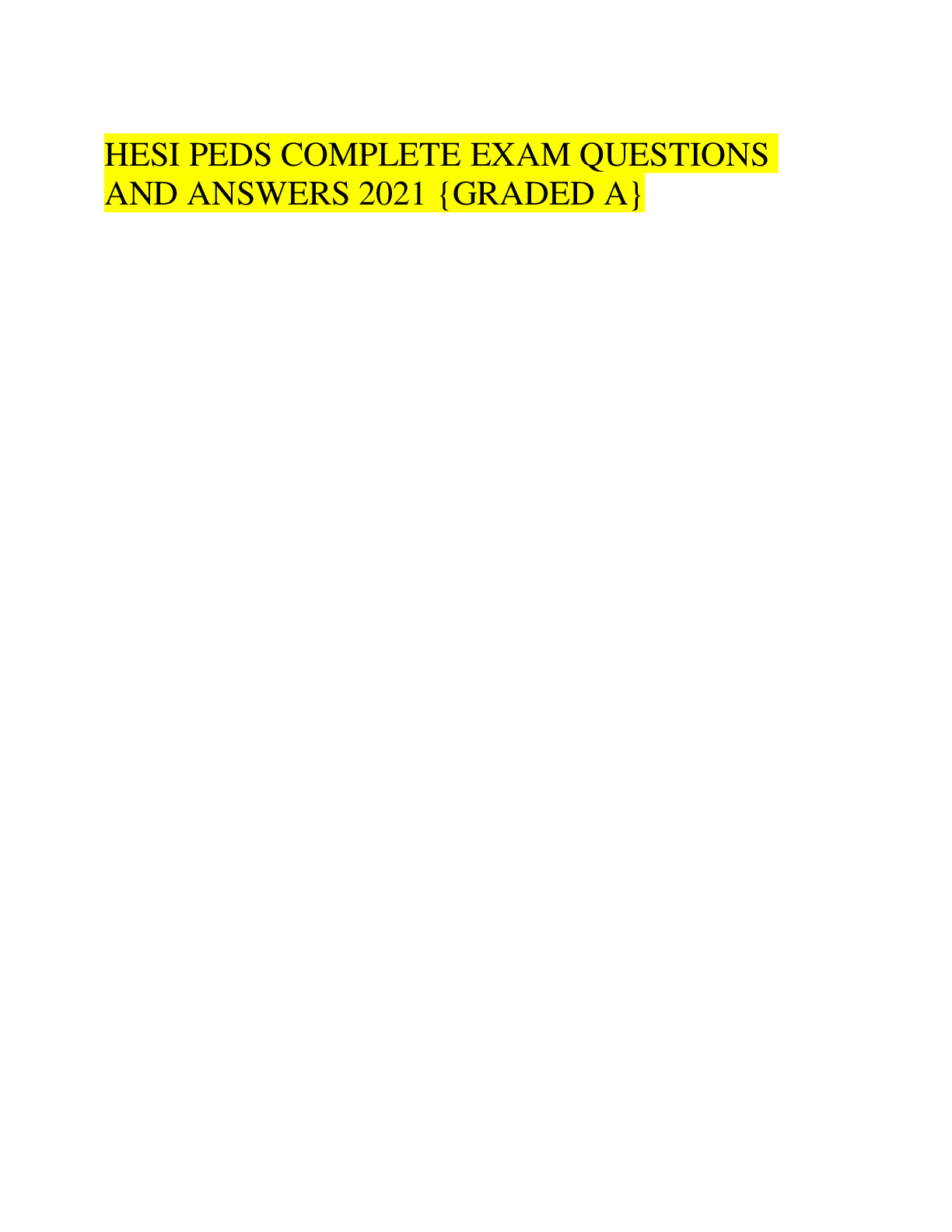
.png)
